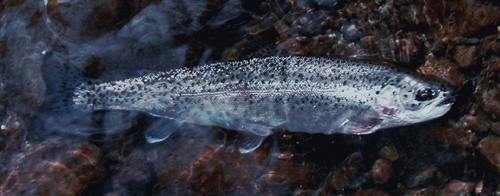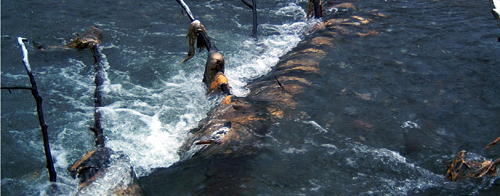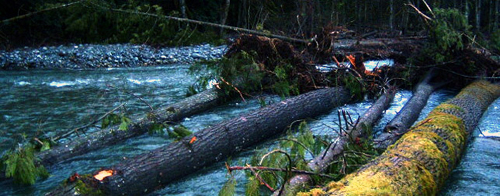WANTED: Trees – DEAD or ALIVE
REWARD: Steelhead
Scott Kirkpatrick
 |
| An outwardly migrating wild steelhead smolt is the supreme indicator of a healthy watershed. (Photo by Dave Hadden) |
To prepare for winter hibernation, black and grizzly bears feed on salmon carcasses. This phenomenon has been researched extensively, and is widely acclaimed as an integral part of the ecosystem of the Pacific Coast rain forests. If a gluttony of salmon carcasses and an ensuing deep sleep are characteristics that can be used to define a bear, then many species of ‘bears’ are being overlooked.
The Wild Pacific Steelhead Trout (Oncorhynchus Mykiss) is such a species. Winter is a time when a river’s ecosystem often can not produce enough invertebrates alone to sustain juvenile steelhead, considering such sustenance would come at considerable cost. Accordingly, steelhead juveniles spend much of the fall season aggressively bulking up fat reserves in preparation for the months to come. The metabolism of steelhead drops dramatically during the winter months, as a result of encountering icy water temperatures. Like bears, these cold-blooded fish are able to survive by drawing energy from fat reserves that have been augmented by, among other things, salmon carcasses. Surviving the winter is a significant obstacle juvenile steelhead face. As is often said, “’Almost only’ counts in horseshoes and hand grenades”, and there are no compromises in this life or death situation.
 |
| Chehalis River, November ; a perfect example of functioning large woody debris: This log has created a resting pool below, a spawning tail out above, and has become a smorgasboard for juvenile steelhead and the food chain after it was caked in Chum salmon carcasses. (Photo by Scott Kirkpatrick) |
Trees, dead or alive, are almost as important to juvenile steelhead survival as water. A treed riparian habitat is a large contributor of pieces of woody debris to the river. Over the course of floods and receding river levels, this debris often settles itself into debris traps in the shallow sections of rivers. The current then forces itself around these dead pieces of wood, and creates pools in which juvenile steelhead can rest and places for them to hide from predators (also known as habitat complexity). Additionally, these new pools serve as areas that settle out (“recruit”) smaller pieces of gravel that are easier for female steelhead to move with their tails. Even better, these debris traps also “pitchfork,” “hang out to dry,” or catch salmon carcasses and hold them there over the course of the winter floods, giving the juvenile steelhead an extended feeding window and retaining a nutrient source into the spring.
Forests, especially old-growth forests, serve as huge reservoirs with their ability to store large amounts of rain water, purifying and slowly releasing it back into the river. The effect…stable river levels that do not see the extreme fluctuations in flow which can cause juveniles seeking refuge to be stranded. With moderated rivers, any woody debris that does end up in the stream doesn’t get washed out right away, or end up “high and dry” up on the bank where it is of little use in creating pool habitat, subsequent spawning habitat, and collecting carcasses.
“Trees, dead or alive, are almost as important to juvenile steelhead survival as water.”
 |
| These logs have dissipated the current which has resulted in a resting area for migrating adults and feeding juveniles. (Photo by Scott Kirkpatrick) |
In a relatively recent article titled “Salmon Survival Rates Triple When Salmon Carcasses Are Left,” by Ed Hunt in the October/November 1997 Edition of Salmon-Trout-Steelheader, Scientist Robert Bilby noted that:
“…in a steelhead’s first year of life, 85 percent of stomach contents were spawner derived. After one year, egg and carcass material made up 95 percent of stomach content.”
The article also talked about a test that was performed:
“On Forks Creek, 400 carcasses were added to 5 meters of stream. They actually tethered the carcasses to make sure they stayed in one place. The results were clear. Not only did young Coho density increase after carcasses were deposited compared to other sites, but steelhead moved in very rapidly after the carcasses were placed in the river, and disappeared after they were gone. The weight of Coho also increased wherever the carcasses were placed as did the amount of fat for Coho and steelhead in the area.”
Without woody debris traps in rivers, many rivers would be too shallow and fast to support anything other than what may be considered by biologists to be functionally extinct populations. The gravel would be mainly large cobblestones too large for all but the largest of female steelhead to move with their tails to create suitable redd sites. There would be few resting areas for juveniles and little habitat complexity. All debris, and any drifting carcasses, would get washed out of the stream with any rise in river levels.
With these factors in mind, it should be obvious that logging watersheds in an irresponsible manner will lead to the eventual extinction of some salmon races, especially steelhead.
